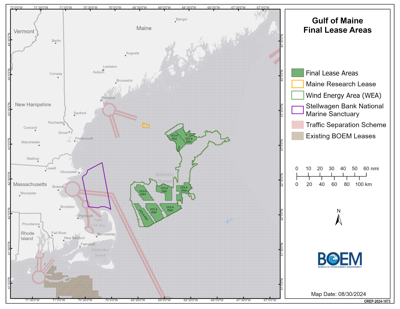NOTES BETWEEN PRINTED EDITIONS
(Indefinite shutdown of power production at Vineyard Wind, but….)
Wind Energy Developers Eye Waters East Of Massachusetts
Two Companies Lease Four Vast Tracts In Gulf Of Maine

OCT. 29, 2024…..The offshore wind energy action has mostly rippled through the waters south of Massachusetts, but things are heating up to the east of the state now too.
The federal government on Tuesday announced two provisional winners of four lease areas in the Gulf of Maine, which is due east of the coasts of Maine, New Hampshire and Massachusetts.
One winner, Avangrid, is already working on the Vineyard Wind project to the south of Martha’s Vineyard and Nantucket and will now eye a foothold in a vast new tract of ocean waters.
The Department of Interior sees the Gulf of Maine as the likely host of the first commercial floating offshore wind installations on the Atlantic Coast. The lease areas, which received combined winning bids of $21.9 million, have the potential to power more than 2.3 million homes with clean energy, the Biden administration said.
Officials dubbed the lease sale as a “significant milestone” toward President Joe Biden’s goal of deploying 30 gigawatts of offshore energy capacity by 2030 and 15 gigawatts of floating wind energy by 2035.
“With ten approved offshore wind projects capable of powering over 5 million homes, we are well on our way to a clean energy future,” said Secretary of the Interior Deb Haaland. “Today’s successful auction marks yet another critical step in our fight against climate change. Together, we can create good paying jobs, build a domestic supply chain, and ensure that the momentum of this offshore industry continues for generations to come.”
Each of the two provisional winners won leases for two areas.
Avangrid, the energy giant behind the landmark-but-stalled Vineyard Wind installation, won a 98,685 acre area for $4.93 million and another 124,900 area for $6.2 million. Both of those tracts sit on the Outer Continental Shelf, about 29.5 nautical miles from Massachusetts and well northeast of where the company is already building turbines.
The other two leases went to Invenergy NE Offshore Wind, LLC. That company won one lease for 97,854 acres about 46.2 nautical miles from Maine for nearly $4.9 million, and another for 117,780 acres about 21.6 nautical miles from Massachusetts.
Some fishing and seafood industry groups have been wary about the energy transition, arguing that ocean development could negatively affect fish populations.
“In the coming years, this unprecedented disturbance of ocean ecosystems is likely to have severe impacts on both the species living in these ecosystems and the fishing communities who have depended on them for centuries to provide seafood to the American public,” the Massachusetts Fishermen’s Partnership group wrote on its website.
Angela Sanfilippo, president of the Gloucester Fishermen’s Wives Association, said she worries the new installation could cut into available fishing territory and make it more difficult for fishermen to access the Georges Bank hotspot.
“Those are fishing grounds. Our people have fished and they’ve brought food to the docks for the last 400 years,” she said of the Gulf of Maine lease area. “Now, we are giving up our food for offshore wind.”
Kate Sinding Daly, senior vice president for law and policy at the Conservation Law Foundation, described the lease sale in the Gulf of Maine as “a pivotal step in our clean energy transition and for the region to significantly reduce climate-damaging emissions.”
“More powerful storms, warming oceans and rising sea levels, and higher temperatures caused by our overheating planet are threatening our lives and livelihood. In order to secure affordable, clean energy, improve public health, and strengthen our economy, we must continue to responsibly develop offshore wind,” Sinding Daly said.
CLF has been pushing the federal government and wind developers to minimize any project impacts on North Atlantic right whales, including by excluding the most important habitats from development areas.
Federal officials stressed the lease awards do not automatically allow construction or operation of any offshore wind facilities, and instead allow developers to submit a project plan for review by BOEM.
Companies committed as part of the bids to invest more than $2.7 million in workforce training and domestic supply chain development, plus another $2.7 million for “fisheries compensatory mitigation,” according to DOI.
Lease stipulations also call on the companies to make “every reasonable effort” to reach project labor agreements for construction of any projects in the areas, and to craft communication and engagement plans with Native American Tribes, agencies and fisheries.
Lawmakers, especially in Massachusetts, and clean energy advocates view offshore wind as a critical piece in the campaign to transition away from fossil fuels. Vick Mohanka, director of the Sierra Club’s Massachusetts chapter, said Tuesday that offshore wind “is the surest pathway to putting gas in the past in Massachusetts and setting our grid up for electrification.”
“As New England continues to use more and more electricity, this growing power demand can be met with clean, pollution-free offshore wind generation. Development in the Gulf of Maine will not only generate needed electricity but create jobs and investment for New England,” added Anne Reynolds, the American Clean Power Association’s vice president for offshore wind. “With today’s lease sale building on earlier deepwater auctions on the West Coast, the United States is truly on track to become a global leader in floating offshore wind technology.”
However, the industry has been beset by headwinds, including rising prices that prompted some developers to rethink their plans and a blade failure that prompted the indefinite shutdown of power production at Vineyard Wind.

